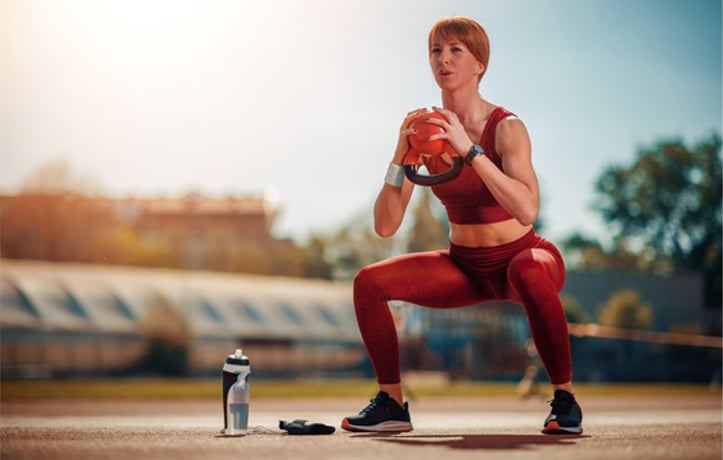What’s the definition of goblet squats? Your new best friend for building stronger glutes! This exercise isn't just a fitness trend; it's a game-changer for anyone looking to amp up their lower body strength.
In this article, we'll walk you through the nitty-gritty of goblet squats - from the perfect technique to their benefits. Whether you're a gym newbie or a seasoned pro, get ready to discover how this powerhouse move can elevate your workout routine.
Table of Contents
● How to Do a Goblet Squat
● What Do Goblet Squats Work?
● Goblet Squat vs. Traditional Squat: What's the Difference?
● Goblet Squat Benefits
● Goblet Squat Variations to Boost Your Workout
💪🏻 Want to become an expert on effective exercise techniques with NASM's
Certified Personal Trainer (CPT) certification? Learn more about NASM’s CPT program here.
How to do a goblet squat
Goblet squats begin with choosing your weight - be it a kettlebell or a dumbbell. The key is to hold this weight close to your chest. This not only helps in maintaining an upright posture but also ensures that the focus is squarely on strengthening your lower body.
Steps to perfect goblet squats:
- Position yourself: Start by standing with your feet shoulder-width apart. This stance provides stability and balance.
- Weight placement: Grasp the weight and hold it at chest level. This is crucial for maintaining proper posture throughout the exercise.
- The squat: Now, lower your body into a squat. Remember to keep your back straight as you do this.
- The rise: Finally, push up through your heels to return to the starting position. This movement helps engage the right muscle groups.
With the steps clear, let's focus on the specifics of form to maximize your goblet squat's effectiveness.
Nailing the proper goblet squat form
Proper form isn't just about looking good; it's about making each squat count. Here’s what you need to keep an eye on:
- Upper body posture: Keep your chest up and shoulders back. This posture is essential for a strong and safe squat.
- Knee alignment: As you squat, watch your knees. They shouldn’t extend past your toes to prevent undue stress on the joints.
- Core engagement: Engage your core throughout the movement. This provides stability and power.
Now that you've got the form down, let's address some common pitfalls to avoid.
Common mistakes to avoid
To get the most out of your goblet squats and stay injury-free, steer clear of these common errors:
- Over-leaning: Avoid leaning too far forward. This can put unnecessary strain on your back.
- Shallow squats: Make sure you squat deep enough to engage the right muscles fully.
- Knee position: Be cautious not to let your knees cave in. This ensures a safer and more effective squat.
What do goblet squats work?
Goblet squats primarily target the lower body, including the quadriceps, hamstrings, glutes, and core. They also engage the upper back and shoulders due to the weight being held at the chest.
💪🏻 Get the breakdown of the muscles engaged during squats in our article, Squat Biomechanics Explained.
Goblet squat vs. traditional squat: what's the difference?
When we talk about goblet squats, think of them as the versatile cousin of the traditional back squat. The key difference lies in how you hold the weight.
In goblet squats, you hold the weight (like a kettlebell or dumbbell) in front of your chest. This front-loaded position changes the game by shifting more emphasis to your glutes and quads. It's like putting the spotlight on these muscles, making them work harder.
In contrast, traditional back squats, where the weight rests on your shoulders, tend to focus more on the posterior chain – that's your hamstrings, glutes, and lower back. They're great for overall lower body strength, but the goblet squat brings something different to your workout table.
Now, let's explore the various benefits that make goblet squats a must-have in your fitness regimen.
Goblet squat benefits
From improving posture to building strength, the advantages of goblet squats are numerous.
- Posture and mobility boost: Goblet squats are fantastic for improving your posture and increasing mobility, especially in the hips and ankles.
- Beginner-friendly: If you're just starting out, goblet squats are a great entry point. They're easier to master than traditional squats and are gentler on your back.
- Core strength: These squats also give your core a serious workout, as it works overtime to stabilize your body during the exercise.
- Full-body workout: Despite their focus on the lower body, goblet squats engage multiple muscle groups.
To keep your routine dynamic, consider these goblet squat variations.
Goblet squat variations to boost your workout
These variations add diversity to your workouts, challenging different muscle groups.
- Elevated goblet squats: By elevating your heels (say, on a weight plate or a small block), you shift the focus even more onto your quads, making them work harder.
- Dumbbell goblet squats: Switching to a dumbbell changes the weight distribution slightly, offering a new challenge to your muscles.
- Spice it up: Don't stop there – try pulse goblet squats for an extra burn, single-leg goblet squats for a balance challenge, or wide-stance goblet squats to target different muscle groups.
💪🏻 Expand your knowledge and skills in fitness with NASM's educational courses.
Final thoughts…
Goblet squats are more than just an exercise; they're a versatile tool for enhancing your fitness journey. Incorporating them into your routine promises improved strength and mobility.

















